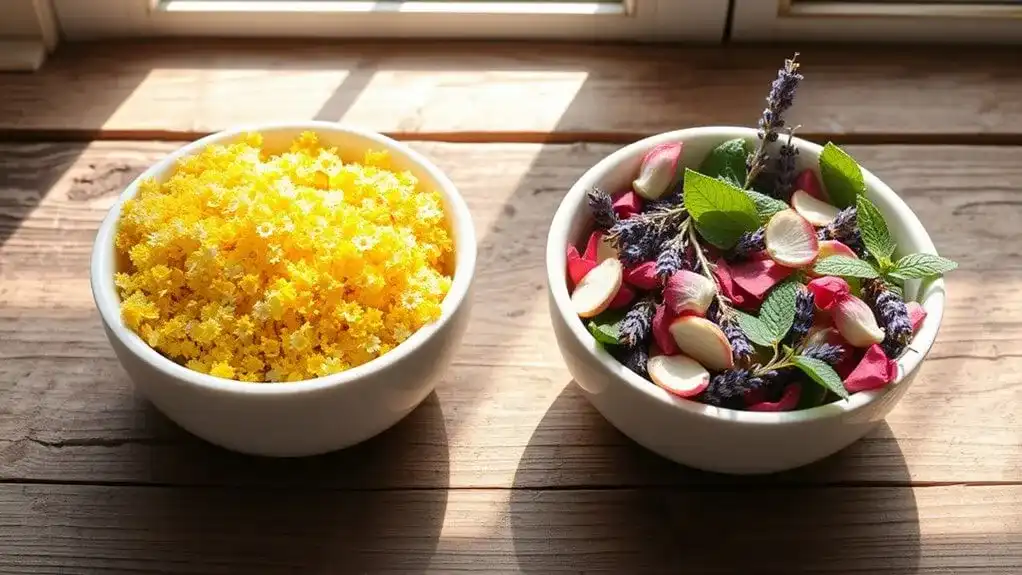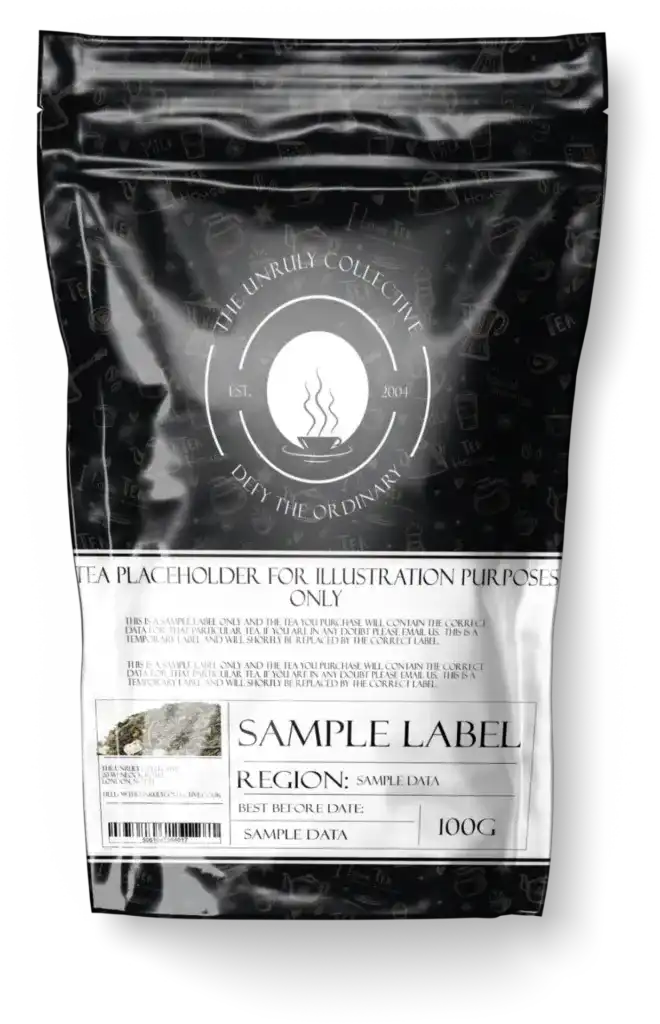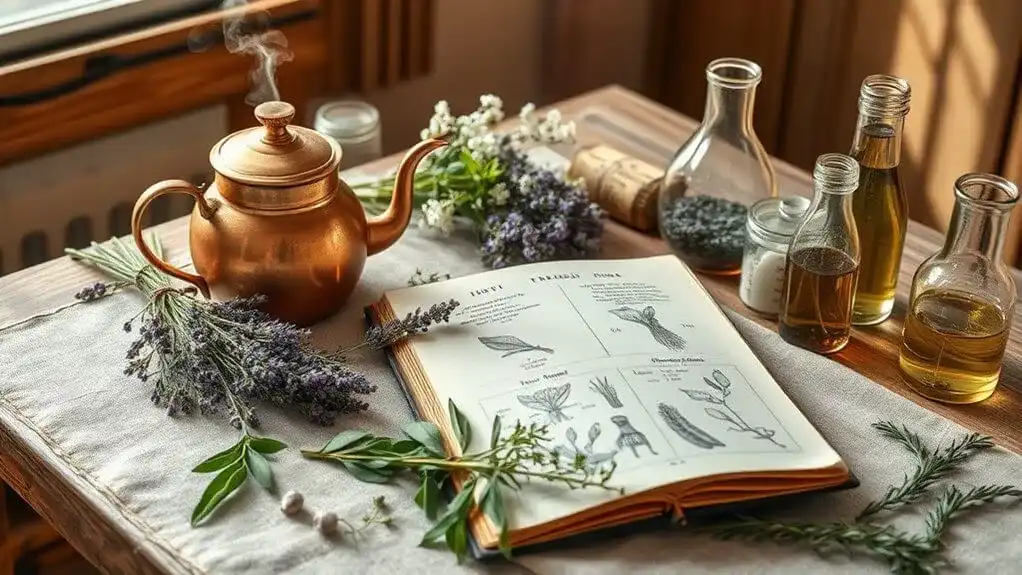Single origin herbs offer unique regional characteristics and therapeutic properties, while herbal blends combine multiple herbs for enhanced synergistic effects. When crafting infusions, single origin herbs showcase distinct flavors and benefits tied to their growing conditions, while blended herbs follow a 3:1:1 ratio of base, accent, and functional herbs for best results. Both approaches require proper storage and preparation techniques, with glass containers and precise steeping times being essential. Discovering the right balance between these methods opens up a world of herbal possibilities.
Key Points
- Single-origin herbs offer distinct flavors and therapeutic properties from specific regions, while blends combine multiple herbs for enhanced effects.
- The classic 3:1:1 ratio (base:accent:functional) serves as a foundation for creating balanced herbal blends.
- Single-origin herbs provide better traceability and consistent quality, making them ideal for understanding individual herb properties.
- Proper steeping times vary: 5-10 minutes for flavor extraction in blends, 8-12 hours for optimal medicinal benefits.
- Starting with single herbs helps develop familiarity before advancing to creating personalized therapeutic blends.
Understanding the World of Single Origin Herbs
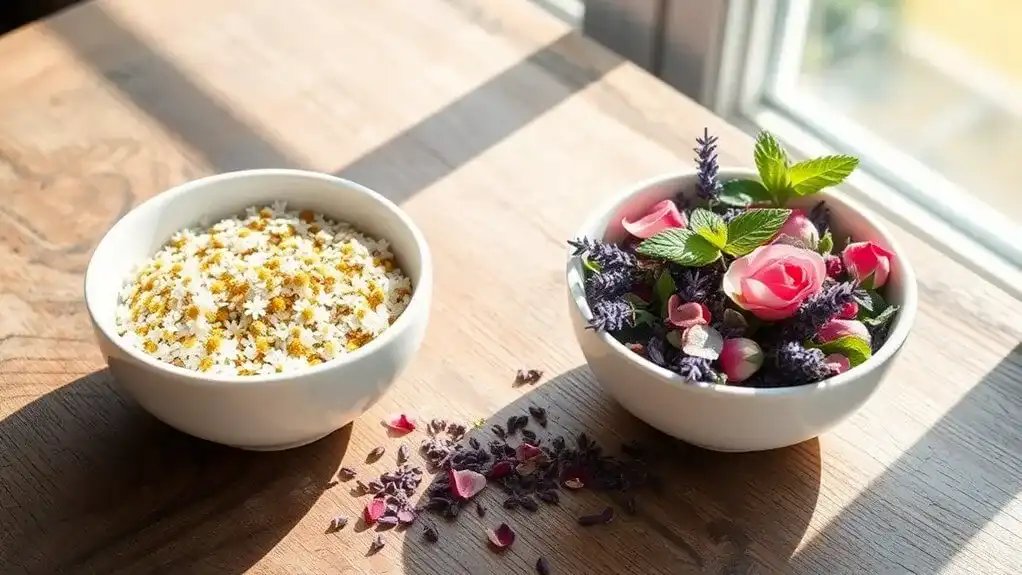
While many people are familiar with common herbs and spices, single origin herbs offer a unique dimension to culinary exploration. These carefully sourced ingredients come from specific regions worldwide, each boasting distinct flavor profiles and regional characteristics. From Sri Lanka's aromatic cinnamon to Zanzibar's hand-picked Pemba cloves, these herbs tell a story of place and tradition. Fair trade practices support local farming communities in these regions. Poor storage in supermarkets often leads to stale spices with diminished flavors. Like single-origin coffee, these herbs showcase distinctive qualities influenced by their unique growing conditions.
Beyond their culinary applications, single origin herbs often provide significant health benefits, such as the anti-inflammatory properties of Indian turmeric. Ethical sourcing and traceability importance have become paramount, with artisan farming practices ensuring sustainability and quality. Small family farms maintain traditional growing methods, producing herbs with higher volatile oil content and more pronounced flavors. This commitment to authenticity and origin-specific cultivation results in pure, unadulterated herbs that elevate both everyday cooking and specialized dishes.
The Art of Herbal Blending: A Deep Dive
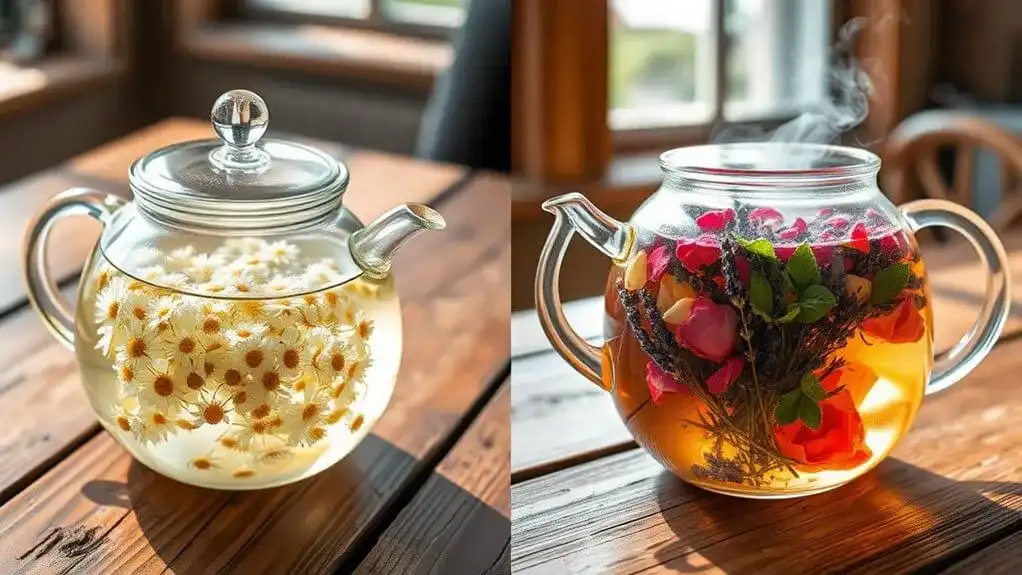
The art of herbal blending transforms simple ingredients into complex, harmonious infusions that delight both the palate and senses. The key to successful blending lies in understanding the fundamental 3:1:1 ratio of base, accent, and functional herbs, which provides a framework for flavor exploration and herbal creativity. Steeping these blends in hot water for 5 to 10 minutes ensures optimal flavor extraction.
Master blenders start with versatile base herbs like rooibos, chamomile, or peppermint, then layer in accent herbs such as ginger or echinacea for enhanced flavor profiles. They'll often experiment with mini blends in a 3:1 ratio before scaling up their creations. For those seeking relaxation, combining chamomile with lavender and lemon balm creates a soothing evening blend. For beginners, combining two blends with the same base herb offers a safe entry point into the craft. Starting with a 1:1 ratio for initial mixing helps establish a baseline for flavor adjustments.
The process requires careful attention to quality, proper storage, and thoughtful pairing of complementary ingredients to achieve balanced, memorable infusions.
Essential Equipment and Techniques for Herbal Infusions
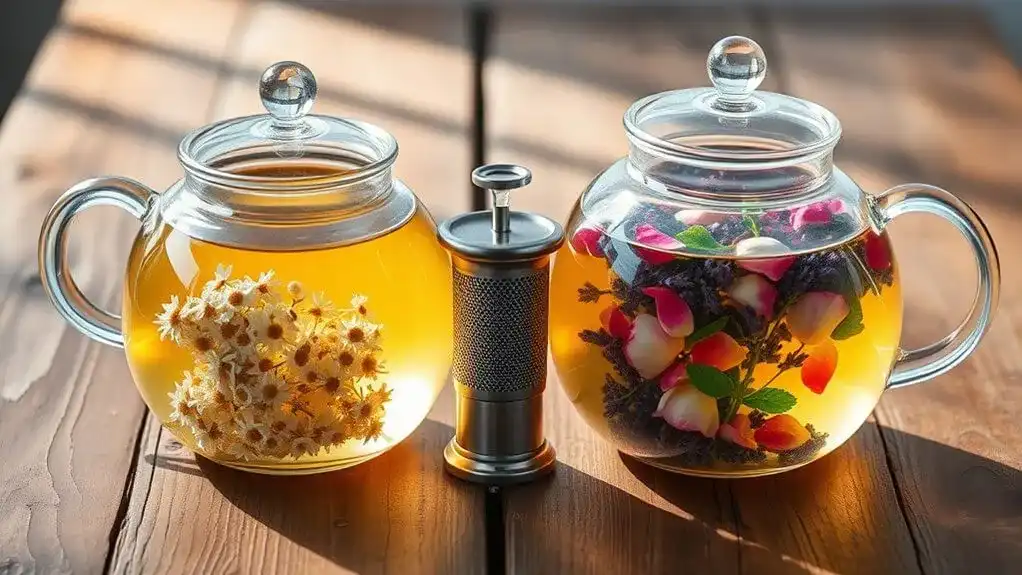
Successful herbal infusions rely on proper equipment and precise techniques to extract the full potential of botanical ingredients. When it comes to herb preparation, practitioners need heat-proof containers, fine-mesh strainers, and non-reactive vessels like glass or stainless steel teapots. They'll also want to avoid aluminum materials, which can react with herbal constituents. Dried herbs are preferred over fresh ones to prevent potential moisture-related spoilage. For optimal medicinal benefits, longer steeping times of 8-12 hours are recommended. Therapeutic preparations require higher herb ratios compared to regular herbal teas.
The key infusion techniques involve precise measurements, typically using a 1:16 ratio of herbs to water. For ideal results, bring water to a boil, pour it over the herbs, and cover immediately to retain volatile oils. Steeping times vary from 5-20 minutes, though delicate herbs require less time to prevent bitterness. Once steeped, strain the infusion and serve it promptly. For best results, always use clean equipment and high-quality herbs.
Making the Most of Single Origin Herb Properties
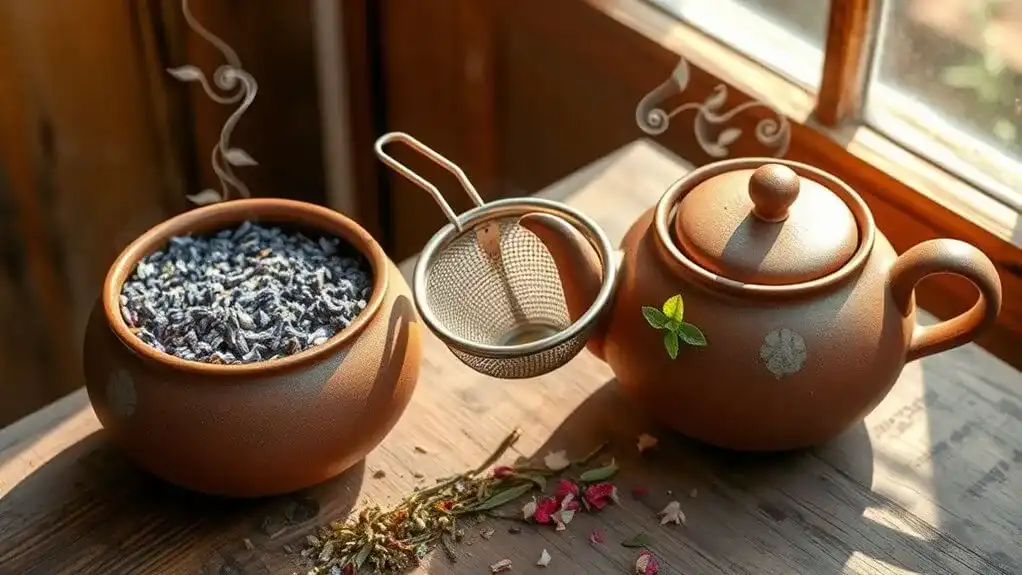
Understanding single-origin herbs' unique properties transforms ordinary infusions into extraordinary botanical experiences. One of the key single origin advantages lies in the distinct flavor profiles that develop from specific regional conditions, including soil composition and climate. These environmental factors contribute considerably to flavor diversity and bioactive compound content. Traditional spice foragers and farmers often work with single places of origin to maintain the authenticity and quality of their products.
When crafting infusions with single-origin herbs, you'll benefit from their enhanced traceability and consistent quality. The herbs' growing conditions directly influence their nutrient content and therapeutic properties, from antioxidant levels to specific health benefits. Single-origin sourcing also guarantees better quality control and reduced contamination risks. By choosing these herbs, you're not just getting superior flavors – you're supporting sustainable farming practices and preserving traditional cultivation methods that have been refined over generations in specific regions.
Mastering the Balance in Herbal Blends
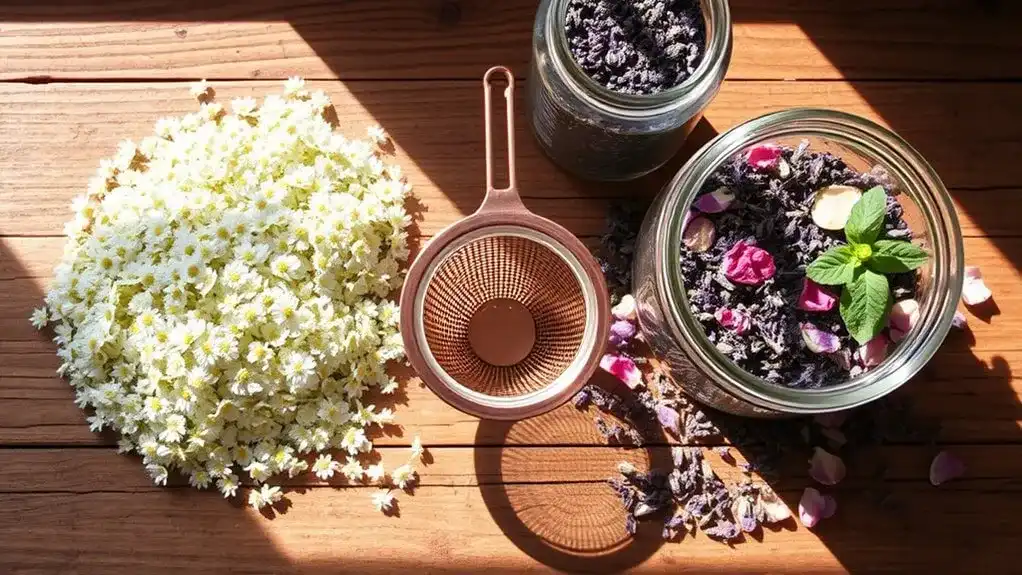
Creating perfectly balanced herbal blends requires mastering both ratios and flavor combinations. The classic 3:1:1 ratio of base, accent, and functional herbs serves as a starting point for achieving flavor harmony. This formula allows herbalists to build well-structured blends while maintaining the desired therapeutic properties. Quality ingredients matter significantly when crafting herbal blends.
Beyond ratios, energetic balance plays an important role in crafting effective blends. It is vital to take into account the heating, cooling, drying, and moistening qualities of each herb. For instance, combining peppermint's cooling properties with ginger's warming effects creates a balanced digestive blend. A comprehensive review of no more than seven herbs should be included in any formulation to maintain effectiveness. When experimenting with combinations, starting with small batches helps refine the perfect balance. Popular pairings like chamomile with rose, or lavender with lemon balm, demonstrate how complementary herbs can work together to create both flavorful and functional infusions.
Choosing the Right Herbs for Your Wellness Goals
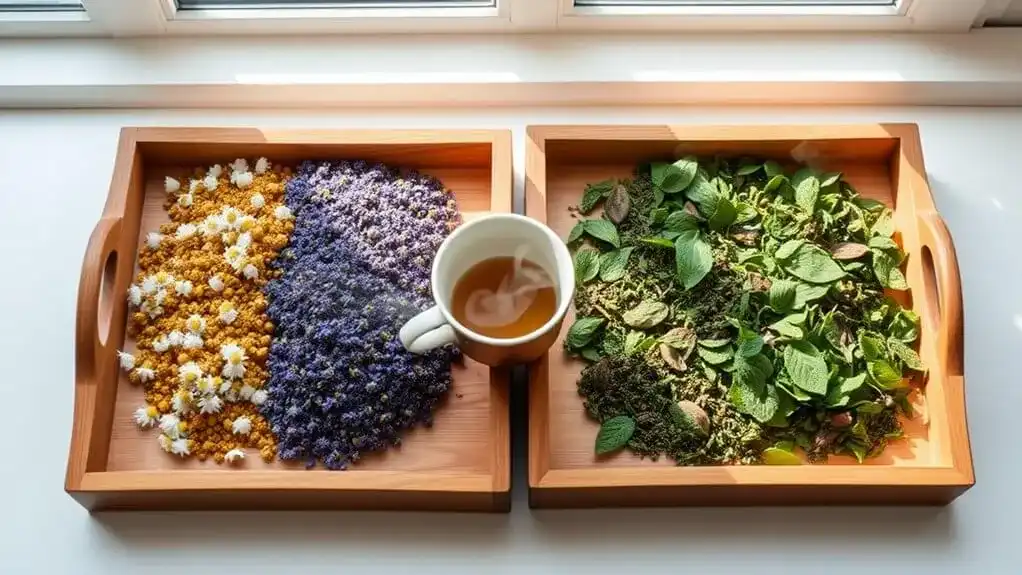
The journey toward ideal wellness begins with selecting herbs that align with personal health objectives. When establishing herb selection criteria, it is crucial to identify specific wellness goals and research each herb's properties thoroughly. Those seeking energy might turn to ginseng or ashwagandha, while individuals focusing on mental clarity could benefit from ginkgo biloba or eleuthero. Natural herbs provide steady energy levels without the crashes associated with caffeine. Experimenting with loose, unprocessed herbs allows users to experience their full therapeutic potential. Maintaining a comprehensive apothecary collection enables consistent access to beneficial herbs.
A methodical approach to herb selection involves evaluating the energetics of different plants and understanding their potential interactions. Starting with single herbs allows for careful observation of their effects before creating personalized blends. As users become more familiar with individual herbs, they can craft synergistic combinations that target multiple wellness goals simultaneously. Keeping detailed records of herbal experiences helps refine choices and guarantees the most effective outcomes for long-term health support.
Best Practices for Storing and Preserving Your Herbs
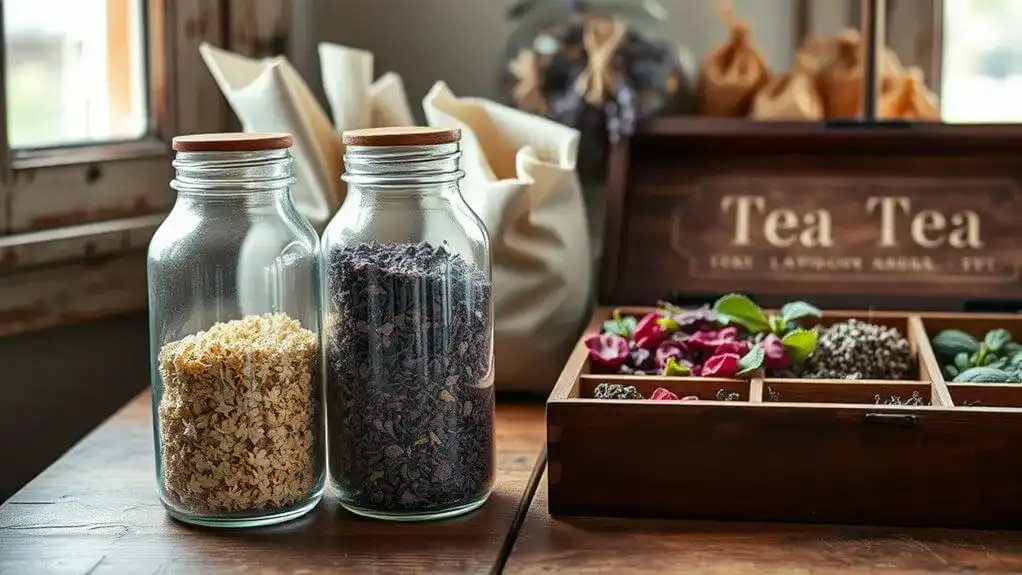
Proper storage and preservation techniques can dramatically extend the life of your herbal collection while maintaining its therapeutic properties. Fresh herbs require careful handling, from washing in cold water to proper drying and storage methods. Consistent testing shows that washing extends freshness significantly compared to storing unwashed herbs.
Several herb preservation techniques offer flexibility based on your needs. For fresh herbs, hardy varieties thrive when rolled in damp paper towels and refrigerated, while tender herbs do best in Mason jars with water. Glass containers protect herbs from degradation and maintain optimal flavor quality for extended periods. Creating herbed butter logs provides a convenient way to preserve fresh herbs while adding flavor to dishes. Basil's unique needs call for room temperature storage in water, away from direct sunlight.
For long-term storage, herbs can be frozen in ice cubes, mixed with oil or butter, or preserved through traditional drying methods. Air drying, oven drying, and dehydrating are all effective approaches. Alternatively, storing fresh herbs in salt provides an ancient yet reliable preservation method that infuses the salt with herbal flavors.
Conclusion
Like a skilled painter with their palette of colors, both single origin and blended herbs offer unique brushstrokes in creating the perfect herbal infusion. Whether one's choosing a pure chamomile experience or crafting complex botanical blends, success lies in understanding each herb's character and how they work together. With proper knowledge, storage, and preparation techniques, anyone can become a master of herbal infusion crafting.
